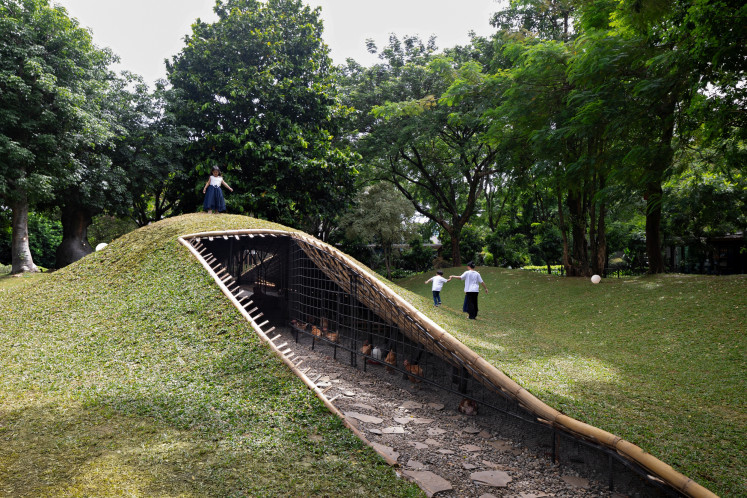Popular Reads
Top Results
Can't find what you're looking for?
View all search resultsPopular Reads
Top Results
Can't find what you're looking for?
View all search resultsNorth Korea's 'army of beauties' set to invade South
Change text size
Gift Premium Articles
to Anyone
 This picture taken in 2005 shows a woman (R) believed to be North Korean leader Kim Jong-Un's current wife Ri Sol-Ju among a group who attended the 2005 Asian Athletics Championships in Incheon. Chosen for their good looks and sharp moves, North Korea's female cheerleaders are a marked contrast to the regime's menacing nuclear ambitions. (AFP/Dong-A Ilbo)
This picture taken in 2005 shows a woman (R) believed to be North Korean leader Kim Jong-Un's current wife Ri Sol-Ju among a group who attended the 2005 Asian Athletics Championships in Incheon. Chosen for their good looks and sharp moves, North Korea's female cheerleaders are a marked contrast to the regime's menacing nuclear ambitions. (AFP/Dong-A Ilbo)
C
hosen for their good looks and sharp moves, North Korea's female cheerleaders are a marked contrast to the regime's menacing nuclear ambitions.
Dubbed the "army of beauties" in South Korea, the young North Korean women -- mostly in their late teens or early 20s -- have attracted huge publicity whenever they have been sent to the South.
North Korean leader Kim Jong-Un's future wife Ri Sol-Ju was among the group who attended the 2005 Asian Athletics Championships in Incheon.
The cheerleaders are set for their fourth appearance in the South after Pyongyang agreed this week to send a delegation to next month's Winter Olympics in Pyeongchang, just 80 kilometres (50 miles) south of the Demilitarized Zone that splits the peninsula in two.
North and South have been totally separated since the end of the Korean War in 1953, with no direct telephone or postal links between them.
Any North Korean delegations to its neighbour are carefully chosen by Pyongyang, and their movements are tightly controlled in the South. According to reports, the Winter Olympics group could be accommodated on a cruise ship moored in Sokcho, making it easier to monitor them.
An Chan-Il, a defector researcher who runs the World Institute for North Korea Studies, said the cheerleaders are cherry-picked by the regime based on tough criteria.
"They must be over 163 centimeters (5ft 3ins) tall and come from good families," An told AFP. "Those who play an instrument are from a band and others are mostly students at the elite Kim Il-Sung University."
Read also: Singapore Airlines alters US route because of North Korean missiles
Samsung phone
The Koreas' separation makes citizens of the North an object of some fascination for Southerners.
The cheerleaders made their first appearance at the 2002 Asian Games in Busan, hitting the headlines when nearly 300 of them arrived on a ferry dressed in colourful hanboks -- traditional Korean dresses -- and waving so-called unification flags, a pale blue silhouette of the whole Korean peninsula.
Hundreds of Busan residents lined the port to greet them, with several homes also flying unification flags.
With their tight choreography -- sometimes using props such as fans -- the cheerleaders were lavished with attention as they sang and danced in the stands.
In 2005, former North Korean cheerleader Cho Myung-Ae -- whose looks had gained her a huge following in the South -- appeared in a television commercial for a Samsung mobile phone with South Korean pop star Lee Hyo-Ri.
The supporters have always proven to be a major ticket draw, and their attendance is good news for the Pyeongchang Games organisers.
"It will help with ticket sales," said Pyeongchang Organising Committee spokesman Sung Baik-You. "It will fulfil our desires for a peace Olympics."
When North Korean teams have played in the South without accompanying supporters, pro-unification South Koreans have turned out to support them, such as at a women's ice hockey match last year in Gangneung, an Olympic venue.
"A joint cheering squad would be phenomenal," said Lee Sun-Kyung, who organised the group.
Read also: Gaza restaurant offers North Koreans discount in gesture to Kim
'Tearful efforts'
But the Northerners' presence also has potential to create some diplomatic headaches.
There are concerns that South Koreans may not be as welcoming as in the past, given their opposition to North Korea's nuclear programme and its increasingly belligerent behaviour.
And displaying the North Korean flag and playing its anthem are illegal in the South, where they are regarded as symbols of sedition under Seoul's national security laws, hence the use of the unification flag at past inter-Korean matches.
When a North Korean flag was draped over a railing at a North-South football game during the 2014 Asian Games in Incheon it was removed by officials.
The rule will not be enforced within the Olympic venues, where IOC protocol applies, but could become an issue elsewhere.
The two teams marched behind the unification flag when they entered the stadiums together for the opening ceremonies of the 2000 and 2004 Olympics in Sydney and Athens, and the 2006 Winter Games in Torino.
But if they do so again at the opening ceremony on February 9, it would mean the South's emblem would not appear on the stadium floor at its home Olympics.
How could the South accept that reality, the Chosun Ilbo newspaper asked in an editorial Wednesday, having secured the Games "through tearful efforts after two failures"?










